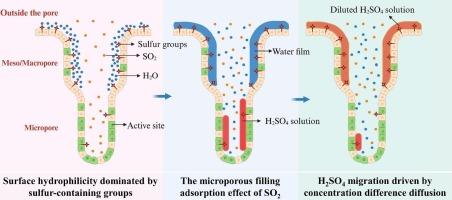用于增强烟气脱硫的硫掺杂碳:协同实验和DFT见解
IF 7.5
1区 工程技术
Q2 ENERGY & FUELS
引用次数: 0
摘要
以SO2为活化剂合成掺硫活性焦(SAC),实现了脱硫剂的同步生产和硫资源的同步利用。本研究通过实验和密度泛函理论(DFT)计算,系统地研究了硫掺杂对碳性能的影响及其增强脱硫机理。结果表明,SO2主要通过与碳的氧化还原反应转化为单质硫(最大收率为92.17%),而掺杂硫主要以噻吩和氧化硫基团的形式存在(最大掺杂率为18.92 wt%)。表面硫掺杂改变了碳的物理化学性质,产生了独特的鞍形SO2吸附曲线。瞬态实验和DFT计算表明,通过增强H2O与含硫基团的相互作用(H2O的最大吸附能达到- 58.70 kJ/mol,是原始无硫碳的2.64倍),促进H2SO4通过浓度梯度扩散在微孔中迁移,从而增强脱硫效果。这项工作为脱硫剂的制备提供了废物资源化策略,并在原子水平上深入了解了SAC的脱硫增强机制,为烟气净化中先进的碳材料提供了设计原则。本文章由计算机程序翻译,如有差异,请以英文原文为准。

Sulfur-doped carbon for enhanced flue gas desulfurization: Synergistic experimental and DFT insights
The synthesis of sulfur-doped activated coke (SAC) using SO2 as an activator enables simultaneous desulfurizer production and sulfur resource utilization. This study systematically investigated the evolution of carbon properties through sulfur doping and the enhanced desulfurization mechanism through experiments and density functional theory (DFT) calculations. The results demonstrated that SO2 was primarily converted to elemental sulfur (maximum yield: 92.17 %) via redox reactions with carbon, while doped sulfur mainly existed as thiophene and oxidized sulfur groups (maximum doping: 18.92 wt%). Surface sulfur doping modified carbon’s physicochemical properties and produced unique saddle-shaped SO2 adsorption curves. Transient experiments and DFT calculations revealed enhanced hydrophilicity through strengthened H2O interactions with sulfur-containing groups (the maximum adsorption energy of H2O reached −58.70 kJ/mol, 2.64 times that of pristine sulfur-free carbon), which promoted H2SO4 migration in micropores via concentration-gradient diffusion to enhance desulfurization. This work provided both a waste-to-resource strategy for desulfurizer preparation and atomic-level insights into the desulfurization enhancement mechanism of SAC, offering design principles for advanced carbon materials in flue gas purification.
求助全文
通过发布文献求助,成功后即可免费获取论文全文。
去求助
来源期刊

Fuel
工程技术-工程:化工
CiteScore
12.80
自引率
20.30%
发文量
3506
审稿时长
64 days
期刊介绍:
The exploration of energy sources remains a critical matter of study. For the past nine decades, fuel has consistently held the forefront in primary research efforts within the field of energy science. This area of investigation encompasses a wide range of subjects, with a particular emphasis on emerging concerns like environmental factors and pollution.
 求助内容:
求助内容: 应助结果提醒方式:
应助结果提醒方式:


